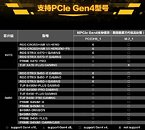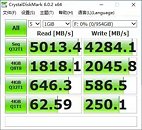Sunday, July 14th 2019

ASUS Begins Enabling Limited PCIe Gen 4.0 on AMD 400-series Chipset Motherboards
ASUS believes that PCI-Express gen 4.0 support on older socket AM4 motherboards based on the AMD 400-series chipset is technically possible, even if discouraged by AMD. The company's latest series of motherboard BIOS updates that expose PCIe Gen 4 toggle in the PCIe settings, does in fact enable PCIe gen 4.0 to all devices that are directly wired to the SoC. These would be the PCI-Express x16 slots meant for graphics, and one of the M.2 slots that has PCIe x4 wiring to the SoC. Below is a list of motherboards scored by Chinese tech publication MyDrivers, which details the extent of PCIe gen 4.0 support across a number of ASUS motherboards based on the X470 and B450 chipsets.
AMD apparently did not explicitly block PCIe gen 4.0 for older chipsets. It merely suggested to motherboard manufacturers not to enable it, since the newer AMD 500-series motherboards are built to new PCB specifications that ensure PCIe gen 4.0 signal-integrity and stability. ASUS wants to leave it to users to decide if they want gen 4.0. If their machines are unstable, they can choose to limit PCIe version to gen 3.0 in their BIOS settings. Among other things, AMD's specifications for 500-series chipset motherboards prescribe PCBs with more than 4 layers, for optimal PCIe and memory wiring. Many of the motherboards on ASUS' list, such as the TUF B450 Pro Gaming, use simple 4-layer PCBs.To test that PCIe gen 4.0 is actually enabled, MyDrivers used a PCIe gen 4.0 SSD on the M.2 slot that's directly wired to the SoC, on a TUF B450M Pro Gaming. Crystal DiskMark sequential read speeds of the drive are consistent with the same drive tested on an X570 motherboard - with just over 5 GB/s reads. These speeds are impossible on gen 3.0 x4. In a separate article, MyDrivers reports that AMD isn't too happy with ASUS marketing PCIe gen 4.0 support on its 400-series motherboards, and is reportedly trying to block it in updates to the AGESA microcode. Our recommendation - if your updated ASUS 400-series motherboard is running PCIe gen 4.0, don't update its BIOS.
Sources:
MyDrivers (main story), MyDrivers (AMD's response)
AMD apparently did not explicitly block PCIe gen 4.0 for older chipsets. It merely suggested to motherboard manufacturers not to enable it, since the newer AMD 500-series motherboards are built to new PCB specifications that ensure PCIe gen 4.0 signal-integrity and stability. ASUS wants to leave it to users to decide if they want gen 4.0. If their machines are unstable, they can choose to limit PCIe version to gen 3.0 in their BIOS settings. Among other things, AMD's specifications for 500-series chipset motherboards prescribe PCBs with more than 4 layers, for optimal PCIe and memory wiring. Many of the motherboards on ASUS' list, such as the TUF B450 Pro Gaming, use simple 4-layer PCBs.To test that PCIe gen 4.0 is actually enabled, MyDrivers used a PCIe gen 4.0 SSD on the M.2 slot that's directly wired to the SoC, on a TUF B450M Pro Gaming. Crystal DiskMark sequential read speeds of the drive are consistent with the same drive tested on an X570 motherboard - with just over 5 GB/s reads. These speeds are impossible on gen 3.0 x4. In a separate article, MyDrivers reports that AMD isn't too happy with ASUS marketing PCIe gen 4.0 support on its 400-series motherboards, and is reportedly trying to block it in updates to the AGESA microcode. Our recommendation - if your updated ASUS 400-series motherboard is running PCIe gen 4.0, don't update its BIOS.



32 Comments on ASUS Begins Enabling Limited PCIe Gen 4.0 on AMD 400-series Chipset Motherboards
I totally understand the need for progress, but PCIe 4.0 is so completely unnecessary right now that the very expensive boards officially supporting it are a bad joke.
Sounds like Nvidia's RTX.... great on paper, expensive, semi-useless in practice.
But well, those that want to be more "future proof" will pick one anyway.
www.anandtech.com/show/14639/no-amd-still-isnt-enabling-pcie-4-on-300400-series-boards
Our plan is unchanged. For the reliability and consistency reasons cited at Computex, we still intend to disable PCIe Gen 4 for pre-X570 motherboards. That AGESA is being released to motherboard manufacturers soon.Ah, but PCIe 4.0 will have a real use case soon enough, whereas RTX will never perform well on current cards...It's all about the board design. If the x16 slot is too far from the CPU socket, it might not work. Same goes for the M.2 slot.
These boards weren't designed for PCIe 4.0, so you get signal quality issues if the PCB traces are too long.
This is why AMD decided against going ahead with this, even though they had intended to do so originally.
Guessing the cheaper boards are getting it since they have fewer pcie lanes used so enabling pcie 4 doesn't affect too much, where crosshair may need to disable other ports which may prevent it from being useful depending on which ports would stop working.
TUF B450 Plus Gaming
VS
TUF X470 Plus Gaming
Anyone using Thunderbolt 3 is using upp four lanes of PCIe 3.0.
Just because You don't use it, doesn't mean there aren't use cases for it.Fake, no, as Asus has clearly advertised it in China by the looks of the presentation posted. However, AMD is set to properly block it soon enough, which might end in tears for some.
This isn't a simple DC wiring problem, it's a time-varying signal which needs to propagate along many transmission lines in the extremely crowded environment of a motherboard PCB. By flipping the switch to double the throughput, you can easily push the circuit outside of it's spec in a number of ways .
- Signal to noise may be violated
- Additional cross talk
- Increased clock jitter
- Disruption of power delivery integrity.
Doubling any switching frequency from a circuit's design spec can break a circuit's capacitive and inductive tuning and completely change the shape of the signal. Anything carrying a current which oscillates in time has the potential to radiate (i.e. becomes an antenna), anything which radiates interacts with and affects its surrounding environment, anything which radiates will be affected by its surrounding environment.
TL : DR - It's not as simple as flipping a switch because electromagnetics are complicated. But also, businesses will be businesses, and only Asus's design engineers would know the exact spec range of their circuitry.
EDIT: I replied to the wrong post because there’s so many similar posts. Sorry